The bedrock of factual writing at Key Stage 1 and 2 is the non-chronological report. In a world where it seems that unsubstantiated ideas can be tossed around like confetti, it feels particularly important to be able to coach children in the discipline of collating and presenting accurate information.
While there are limits to the amount of original or primary-source information we can expect them to research, it’s never too early to learn the basics of presenting knowledge clearly and logically.
If you want some tips and resources for helping you to teach non-chronological writing effectively, here are some ideas we think you might like to know about...
What is a non-chronological report?
Writing a non-chronological report is all about describing things the way they are. Although they might deal with historical information, the key is in presenting the current state of knowledge without necessarily worrying about the order in which things happened or were discovered, hence the non-chronological aspect.
So, for example, you could write about either African animals or Roman Gods as non-chronological reports, even though the latter would be part of a history topic, because they would both reflect our current understanding.
There is a place for other types of report, such as instructions, recounts and explanations. These tend to be chronological but can be taught as genres in their own right in another lesson.
How to structure a non-chronological report
The absence of a chronological order/arrangement of ideas does not mean an absence of order. One of the key structural features of a non-chronological report is logic.
It has to be presented to the reader in a way that makes sense and is easy to follow. To achieve that, you need a plan.
Our KS2 non-chronological report writing template combines clear posters, model text features and structured planning sheets to help pupils understand, identify and apply the key elements of this text type in their own writing.
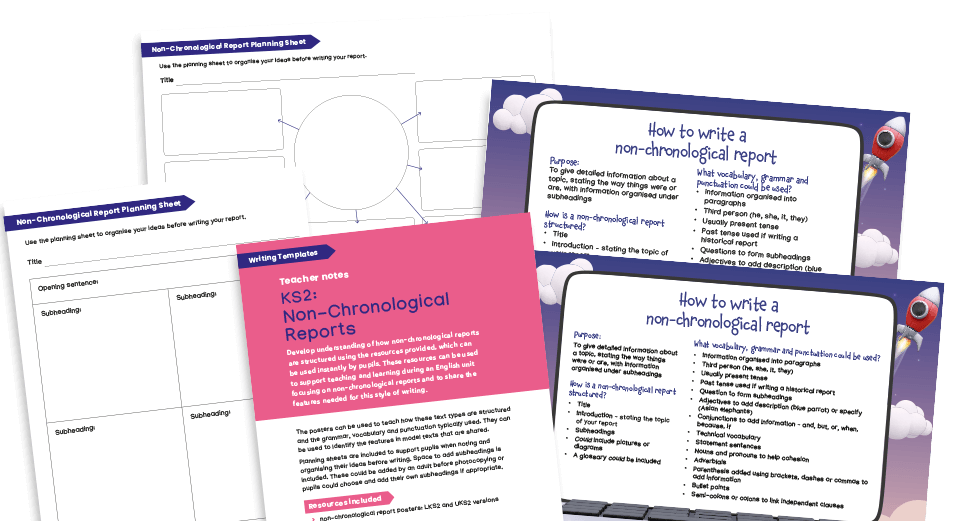 KS2 non-chronological report writing template
KS2 non-chronological report writing templateMeanwhile, our KS1 version contains a clear poster and simple planning sheet that support young pupils in recognising key features, organising ideas and beginning to structure their own writing.
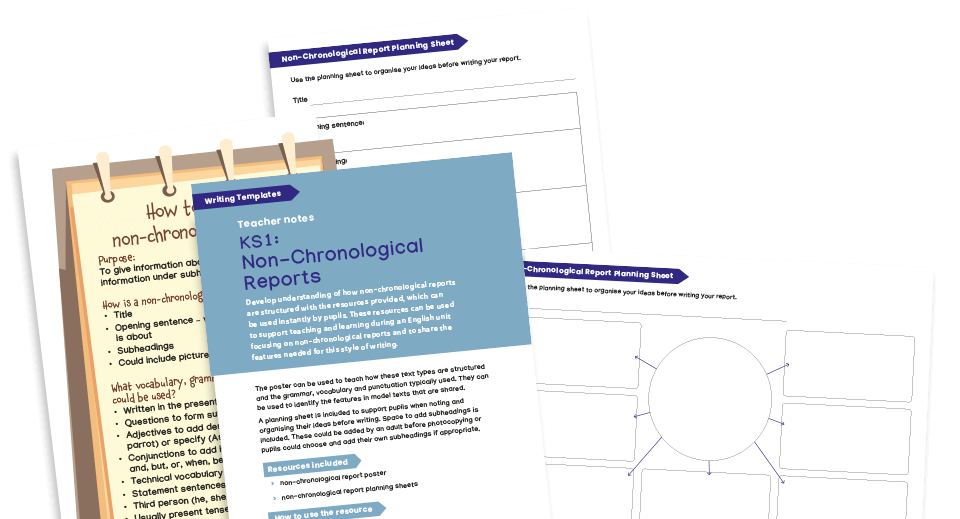 KS1 non-chronological report writing template
KS1 non-chronological report writing template
Non-chronological report examples
When you’re teaching how to tackle any genre of writing, but especially one with as many characteristic features as a non-chronological report, it’s important to allow your class to see some good examples.
Of course, you should be able to find these in non-fiction books. But how often have you set off to look for a suitable extract that you think should be easy to find, only to realise that you’re already an hour into your quest and nothing seems quite right?
This is where our Real Writing model text units can help. We have 150 model text units for Years 1-6, covering a wide range of topics and genres. This includes examples of non-chronological reports. All the texts are written by celebrated children's author.
The chances are, you’ll be able to find a great resource pack among them that covers everything you need.
KS1: Year 1
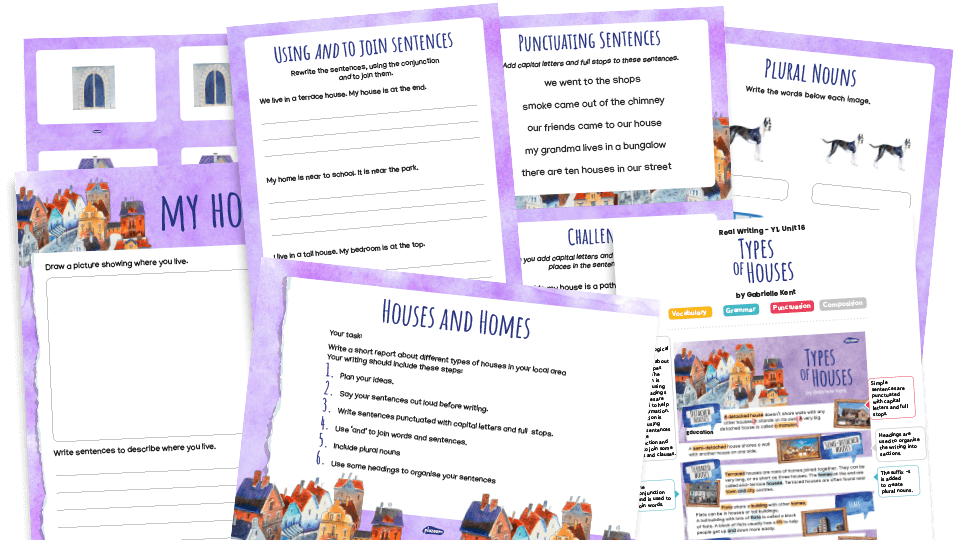
KS1: Year 2
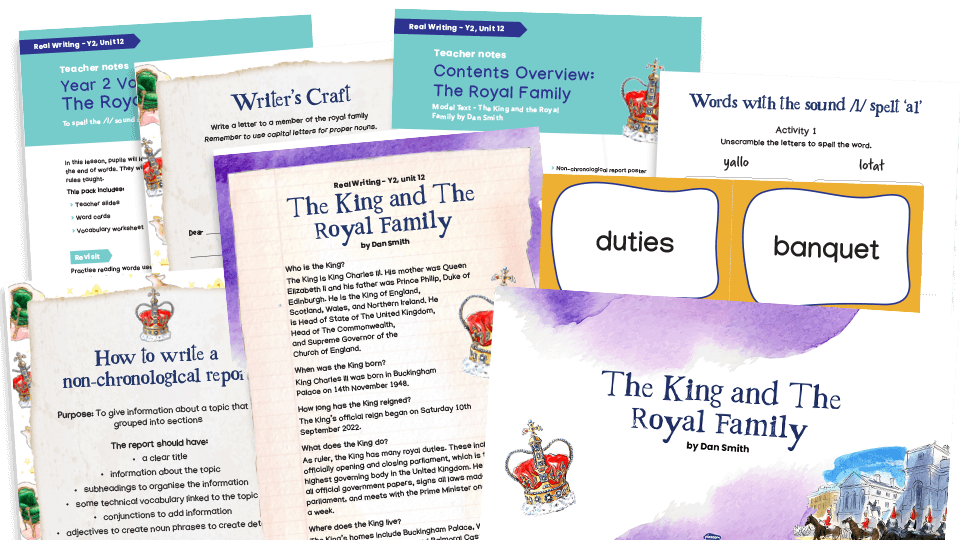
LKS2: Year 3
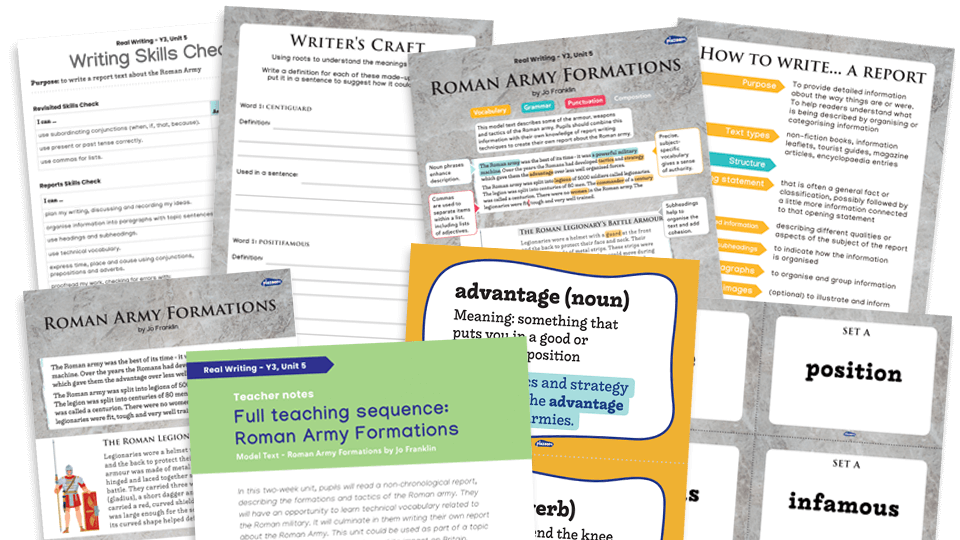
LKS2: Year 4
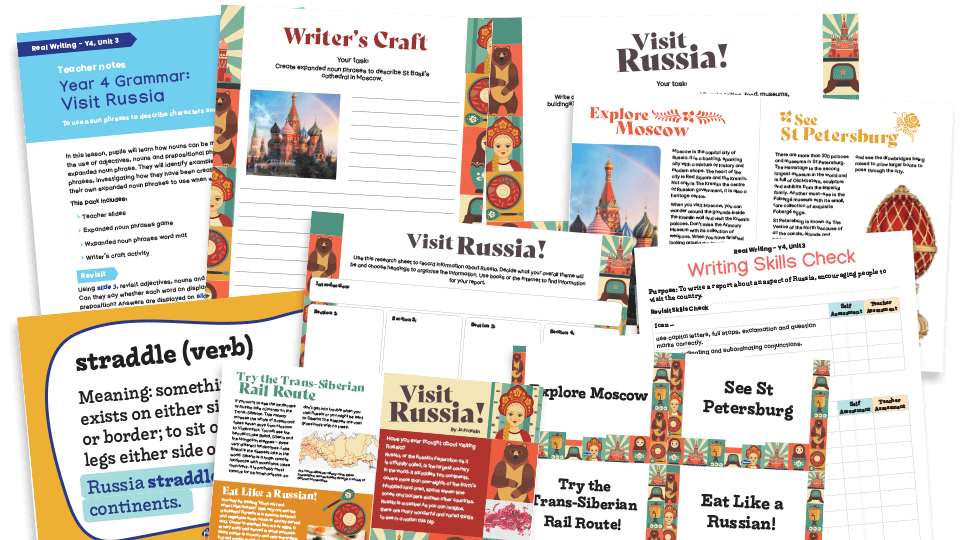
UKS2: Year 5
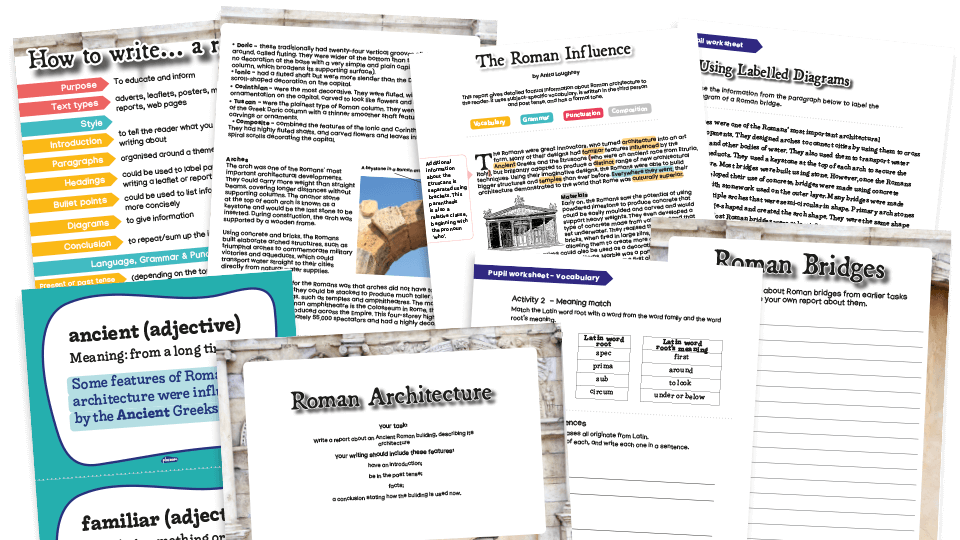
UKS2: Year 6
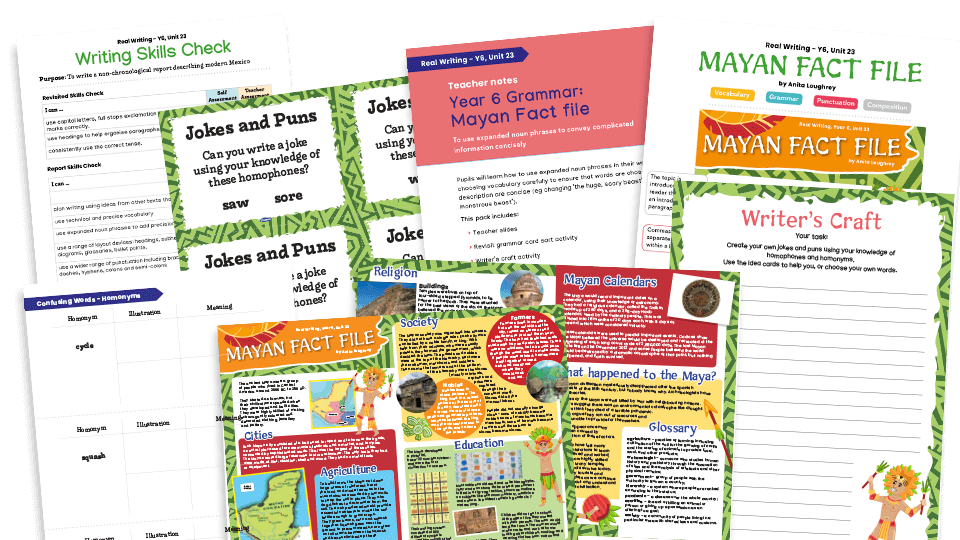
Active reading of report writing
Reading non-chronological reports should not be a passive experience. If you want your pupils to be able to use some key features of the report successfully, they need to be able to understand and identify them first.
Once again, our Real Writing model text units can help you here as you can be confident that they will include the sort of features you would like to see in your pupils’ work.
That gives them the chance to ‘pick apart’ the model texts themselves to find the features and see how they contribute to the overall piece.
Features of a non-chronological report
Obviously, the expectations will be different, depending on the age group. However, some aspects are pretty constant, such as the arrangement of the available material.
Headings and subheadings will be useful for this from Key Stage 1 onwards. These can be worded as correctly punctuated question sentences.
As they grow in confidence and competence, pupils should begin to group information logically into different paragraphs.
Non-chronological reports are also a great opportunity to encourage children to use the correct verb tense or tenses to express their points. Other grammatical features can be introduced at the appropriate age level.
Another idea would be to promote the use of layout devices such as illustrations, tables, bullet points and maybe even the odd fact file.
How to plan a non-chronological report
The effective organisation of the material will absolutely depend on the quality of the plan. There are plenty of ways of doing this. However, a key feature of non-chronological reports is the corralling of information into different sections.
This is also a great genre for practising the art of writing brief notes. Give children permission not to compose full sentences in this context.
Our WAGOLL writing packs are great for this because they include ready-made paragraph planners and research sheets. For example, see our Animals worksheet unit for Key Stage 1 pupils and our Mythical Creatures version for Key Stage 2.
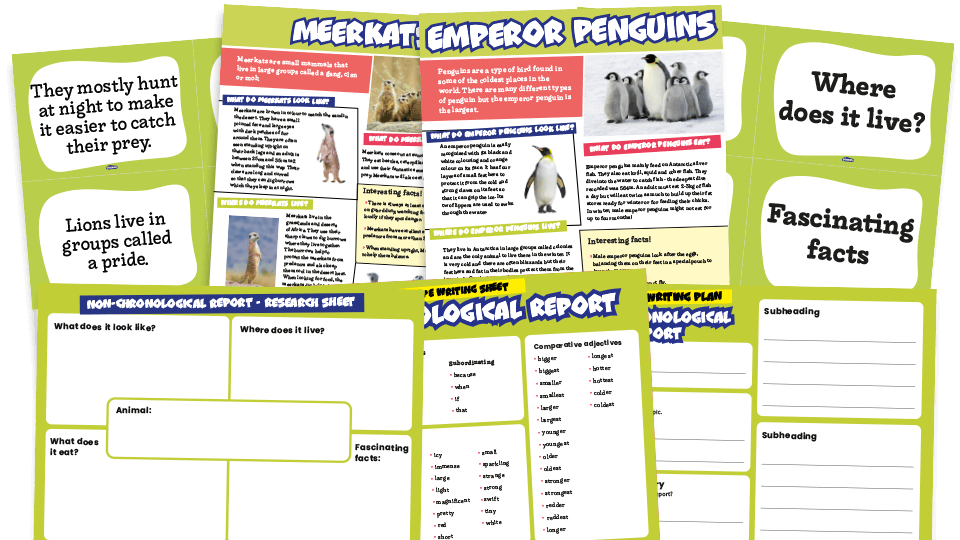 KS1 animals non-chronological report planners and model texts
KS1 animals non-chronological report planners and model textsNon-chronological report writing
Obviously, you will want your class to use some key features of the report successfully. However, as you model how to write a non-chronological report for them, make sure you also place an emphasis on writing in an engaging way that really demonstrates an understanding of their audience.
After all, non-fiction should not be a synonym for dry and functional. Indeed, there is a rising trend in the popularity of non-fiction books. This suggests they are being read for pleasure as well as enlightenment.
Non-chronological report success criteria
Above all, you want to make sure that your KS1 and KS2 students understand the importance of facts and respect the need to convey information clearly and accurately.
With any luck, not only will they blossom into effective writers, but they will also be better at judging what they are reading with a critical eye.
Hopefully, we will then create a generation of people who are better at knowing when they can trust the information they are being presented with.
Sue Drury qualified as a primary teacher in 1999. Teaching pupils from Year 1 to Year 8, she has held a variety of positions including maths and English subject leader, year leader, and assistant headteacher. Sue has mentored students and NQTs, offering guidance and advice using her years of experience. She created many of Plazoom's literacy resources.